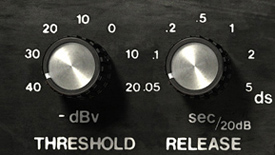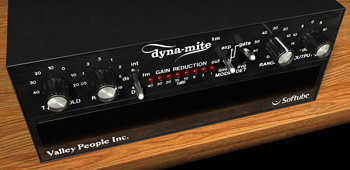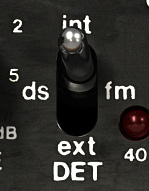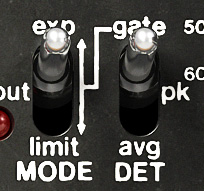Review: Softube Valley People Dyna-mite Plug-In
When I started my career working at a big NYC recording studio, I – like all of the other interns and assistants – just wanted to look at, play and experiment with all of the high-end and unattainable classic gear decking out each room. Although most of us had very little experience with the piles of gear we were exposed to, we all had strong opinions about each piece based on hearsay and watching experienced engineers work with the stuff. The debates never ended and conclusions were rarely reached.
One piece of gear that had a presence in most of the rooms at the studio where I got my start (Chung King) was the Valley People Dyna-mite.
It didn’t hold a place of honor in the producer’s desk, and it always seemed to be racked in the back of the room next to the timelynx and clock generators. Because of its dubious placement in the control room, we tended to treat it as a 2nd or 3rd class piece of equipment, often overlooking it altogether.
Most engineers tended to ignore it, always picking something more tried and true…and if they did go outside of the console for a gate, the Drawmer always seemed to be the first and only choice. After all, that’s what the Dyna-mite is… a gate, right?
When I left Chung King, I have to admit that I don’t recall seeing the Dyna-mite in any of the other studios I frequented, and hence, it slid out of my consciousness. That is, until I was made aware of Softube’s new emulation of this mysterious processor. My first thought was “who needs another gate?” especially in the DAW world where that specific tool was even less necessary than ever before.
My second thought was that there must be something “special” about it that I had overlooked over the years while gleefully being blinded by 1176’s, Fairchild’s, and the rest of the superstars of the outboard world.
SWITCHES & SETTINGS
As it turns out, the Dyna-mite is much more than a gate, and can be configured to be used as many different things:
- A fast attack limiter.
- A slower attack limiter.
- A gate.
- An expander.
- A de-esser.
- Any combination of the above.
Admittedly, I initially had to reference the manual quite a few times to keep track of what exactly it was doing and how to set it. Luckily however, Softube has had the forethought to add a window to the interface that explains each mode as you toggle the switches, so it’s quite easy to get moving quickly.
LIMITING
For the most immediate gratification it is best to start working with the limiter. The basic mode is achieved by setting the detector source switch to INT (internal), the mode switch to limit, and the detector type to either AVG (slower attack) or PK (fast attack). The threshold, release, and range control are all typical in function in this mode.

Classic threshold control: determines the signal level above which limiting, or below which expanding action begins.
Using this on a snare drum will make you smile: instant smashing and pumping that sounds very good right away. In the sheer aggression department, this limiter is a force to be contended with. While it is supposedly more transparent in the AVG mode, it is actually anything but. The minute I heard this thing doing its work I was able to get awesome drum sounds out of it, and quickly too. I almost felt guilty about neglecting some of my other more refined compressors for this work. Almost. The overt character of the Dyna-mite’s limiter screams at the listener: “I used aggressive compression on this track!” and thus, should be used accordingly!
For additional functionality, you can toggle the detector source switch to DS-FM, which adds a high-emphasis filter into the detector circuit. This makes the limiter more sensitive to higher frequencies, allowing for double duty use as a de-esser or simply a way to tame source material with a lot of high end, like cymbals in the overheads for instance. Ultimately, however, I found this functionality better suited to making alterations in the character of the source material, as the limiting functionality is a bit to brutish for fine de-essing.
GATING/EXPANDING
Although earlier I noted that there is some redundancy in using a gate in conjunction with the editing power of the modern DAW, I’m afraid I may have been a bit glib, as I actually use gates all the time. With the right source material they are very quick to solve problems, and also have a distinct sound to them that can add a cool character to different sources.
The Dyna-mite’s gate is no slouch and works very well. The detector source can be set to int (internal) or ext (external) if you’d like to trigger the gate open with another track/sound source. This is perfect for the old hip-hop kick drum trick of triggering (keying) open a gated 60 Hz (or lower) sine wave in conjunction with a regular kick sound. The gate is keyed to open by the original kick source, and then blended with the sine tone: instant low end.
As a matter of fact, after I remembered this trick, I actually incorporated it into a rock track where the kick was only miked on the inside of the drum. I was instantly able to capture some of that bottom end I needed.
Setting the detector source switch to INT, the mode switch to EXP, and the detector type to GATE creates a scenario in which the Dyna-mite behaves like a traditional gate. Any signal that is below the set threshold is reduced by a 20:1 ratio in gain directly proportional to the value set on the range control. Adjusting the detector type to either PK or AVG results in a kindler, gentler gating scenario with longer attack times. The gate exhibits little/no chatter and does what it should well.
I rarely, if ever, use an expander in my work, and experimenting with this aspect of the Dyna-mite made me a believer almost instantly. I had a set of drum tracks that had a lot of room in the overheads, definitely more than I wanted. As I played around with the expander settings I was thrilled to find that I could keep all the space I wanted around the snare/hat/tom attacks but greatly reduce the apparent level of room decay. Awesome!
In this case I had the Dyna-mite set to EXP mode with the detector type on peak. Essentially, any transients above the set threshold are allowed through with the preferred amount of decay, and any transients below the threshold are gently reduced by a 1:2 ratio.
WEIRDNESS!
In the Dyna-mite manual, Softube makes specific mention of “Weird Limiting” mode. Although I have not yet found a use for this, it is an interesting, odd side-effect that may not have been intended in the original Dyna-mite’s design phase.
True to form, the Softube engineers have faithfully modeled this functionality (or lack thereof) into their emulation. If the detector mode is set to LIMIT and the detector type is set to GATE, you end up with a scenario in which any signal above a certain threshold is hard limited. The range and release controls really come into play here. If the range is set too high, you end up hearing nothing except clicking, presumably the attack time of the limiter as it is engaged.
Similarly, if the release time is set too long, you also end up with silence, as the compression takes to much time to be released. However, if your range is set to around 5-6 dB, and the release time around a few ms, you’ll hear some interesting pumping and modulation effects on your source. A fascinating idiosyncrasy that I expect may end up saving the day once or twice over the coming years…
IN SUM
As I have duly noted above, the Dyna-mite is far from a simple gate, in fact it may have more surprises for me still lying in wait. You may ask yourself whether it’s worth the $279.00 price tag, and I would have to answer yes. Although it is not the most romantic of emulations, the fact is that it is now on so many of the sessions that I am working on that it must be worth the price of admission.
At any rate, it is definitely worth checking out the demo available on Softube’s website, you’ll be thrilled the first time you hear that limiter obliterating everything in its path…
Softube’s Valley People Dyna-mite is a plug-in that will work with VST, AudioUnits or RTAS compatible host applications. Click for more information and sound samples. And to purchase the Softube Valley People Dyna-mite plug-in, visit Softube’s U.S. distributor, MV Pro Audio. Visit http://www.mvproaudio.com for more information.
Bo Boddie is a Grammy winning engineer/producer and composer who has worked with Santana, Everlast, Korn, Reni Lane, and many others. He is currently beginning work on Imperial Teen’s second release on Merge Records. Also check out Psychic Friend, his new band with Will Schwartz(Imperial Teen) and Patty Schemel (Hole).
Please note: When you buy products through links on this page, we may earn an affiliate commission.











Geoff Sanoff
March 25, 2011 at 3:56 am (14 years ago)I’m with ya Bo. This one ain’t that romantic but it really is suprisingly cool, especially considering its relative anonymity.
Bo boddie
March 26, 2011 at 10:36 pm (14 years ago)My friend just informed me has two hardware units in his basement in chelsea….if you dare!